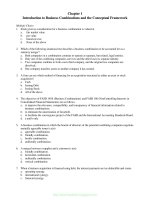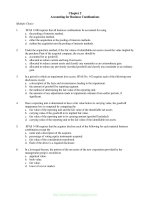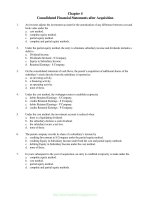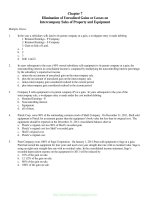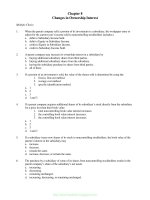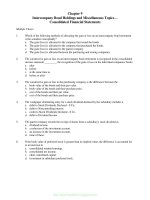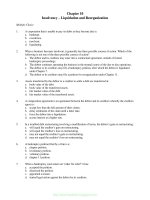Test bank with answers for advanced accounting 3e by jeter chapter 05
Bạn đang xem bản rút gọn của tài liệu. Xem và tải ngay bản đầy đủ của tài liệu tại đây (234.29 KB, 21 trang )
To
Todownload
downloadmore
moreslides,
slides,ebook,
ebook,solutions
solutionsand
andtest
testbank,
bank,visit
visit
Chapter 5
Allocation and Depreciation of
Differences Between Implied and Book Value
Multiple Choice
1.
When the implied value exceeds the aggregate fair values of identifiable net assets, the residual
difference is accounted for as
a. excess of implied over fair value.
b. a deferred credit.
c. difference between implied and fair value.
d. goodwill.
2.
Long-term debt and other obligations of an acquired company should be valued for consolidation
purposes at their
a. book value.
b. carrying value.
c. fair value.
d. face value.
3.
On January 1, 2010, Lester Company purchased 70% of Stork Corporation's $5 par common stock
for $600,000. The book value of Stork net assets was $640,000 at that time. The fair value of Stork's
identifiable net assets were the same as their book value except for equipment that was $40,000 in
excess of the book value. In the January 1, 2010, consolidated balance sheet, goodwill would be
reported at
a. $152,000.
b. $177,143.
c. $80,000.
d. $0.
4.
When the value implied by the purchase price of a subsidiary is in excess of the fair value of
identifiable net assets, the workpaper entry to allocate the difference between implied and book
value includes a
1. debit to Difference Between Implied and Book Value.
2. credit to Excess of Implied over Fair Value.
3. credit to Difference Between Implied and Book Value.
a. 1
b. 2
c. 3
d. Both 1 and 2
5.
If the fair value of the subsidiary's identifiable net assets exceeds both the book value and the value
implied by the purchase price, the workpaper entry to eliminate the investment account
a. debits Excess of Fair Value over Implied Value.
b. debits Difference Between Implied and Fair Value.
c. debits Difference Between Implied and Book Value.
d. credits Difference Between Implied and Book Value.
To
Todownload
downloadmore
moreslides,
slides,ebook,
ebook,solutions
solutionsand
andtest
testbank,
bank,visit
visit
5-2
Test Bank to accompany Jeter and Chaney Advanced Accounting 3rd Edition
6.
The entry to amortize the amount of difference between implied and book value allocated to an
unspecified intangible is recorded
1. on the subsidiary's books.
2. on the parent's books.
3. on the consolidated statements workpaper.
a. 1
b. 2
c. 3
d. Both 2 and 3
7.
The excess of fair value over implied value must be allocated to reduce proportionally the fair
values initially assigned to
a. current assets.
b. noncurrent assets.
c. both current and noncurrent assets.
d. none of the above.
8.
The SEC requires the use of push down accounting when the ownership change is greater than
a. 50%
b. 80%
c. 90%
d. 95%
9.
Under push down accounting, the workpaper entry to eliminate the investment account includes a
a. debit to Goodwill.
b. debit to Revaluation Capital.
c. credit to Revaluation Capital.
d. debit to Revaluation Assets.
10.
In a business combination accounted for as an acquisition, how should the excess of fair value of
identifiable net assets acquired over implied value be treated?
a. Amortized as a credit to income over a period not to exceed forty years.
b. Amortized as a charge to expense over a period not to exceed forty years.
c. Amortized directly to retained earnings over a period not to exceed forty years.
d. Recognized as an ordinary gain in the year of acquisition.
11.
On November 30, 2010, Pulse Incorporated purchased for cash of $25 per share all 400,000 shares
of the outstanding common stock of Surge Company. Surge 's balance sheet at November 30, 2010,
showed a book value of $8,000,000. Additionally, the fair value of Surge's property, plant, and
equipment on November 30, 2010, was $1,200,000 in excess of its book value. What amount, if any,
will be shown in the balance sheet caption "Goodwill" in the November 30, 2010, consolidated
balance sheet of Pulse Incorporated, and its wholly owned subsidiary, Surge Company?
a. $0.
b. $800,000.
c. $1,200,000.
d. $2,000,000.
To
Todownload
downloadmore
moreslides,
slides,ebook,
ebook,solutions
solutionsand
andtest
testbank,
bank,visit
visit
Chapter 5 Allocation and Depreciation of Differences Between Implied and Book Value
5-3
12.
Goodwill represents the excess of the implied value of an acquired company over the
a. aggregate fair values of identifiable assets less liabilities assumed.
b. aggregate fair values of tangible assets less liabilities assumed.
c. aggregate fair values of intangible assets less liabilities assumed.
d. book value of an acquired company.
13.
Scooter Company, a 70%-owned subsidiary of Pusher Corporation, reported net income of $240,000
and paid dividends totaling $90,000 during Year 3. Year 3 amortization of differences between
current fair values and carrying amounts of Scooter's identifiable net assets at the date of the
business combination was $45,000. The noncontrolling interest in net income of Scooter for Year 3
was
a. $58,500.
b. $13,500.
c. $27,000.
d. $72,000.
14.
Porter Company acquired an 80% interest in Strumble Company on January 1, 2010, for $270,000
cash when Strumble Company had common stock of $150,000 and retained earnings of $150,000.
All excess was attributable to plant assets with a 10-year life. Strumble Company made $30,000 in
2010 and paid no dividends. Porter Company’s separate income in 2010 was $375,000. Controlling
interest in consolidated net income for 2010 is:
a. $405,000.
b. $399,000.
c. $396,000.
d. $375,000.
15.
In preparing consolidated working papers, beginning retained earnings of the parent company will
be adjusted in years subsequent to acquisition with an elimination entry whenever:
a. a noncontrolling interest exists.
b. it does not reflect the equity method.
c. the cost method has been used only.
d. the complete equity method is in use.
16.
Dividends declared by a subsidiary are eliminated against dividend income recorded by the parent
under the
a. partial equity method.
b. equity method.
c. cost method.
d. equity and partial equity methods.
To
Todownload
downloadmore
moreslides,
slides,ebook,
ebook,solutions
solutionsand
andtest
testbank,
bank,visit
visit
5-4
Test Bank to accompany Jeter and Chaney Advanced Accounting 3rd Edition
Use the following information to answer questions 17 through 20.
On January 1, 2010, Pandora Company purchased 75% of the common stock of Saturn Company. Separate
balance sheet data for the companies at the combination date are given below:
Pandora Co.
Saturn Co.
Book Values
Saturn Co.
Fair Values
Cash
Accounts receivable
Inventory
Land
Plant assets
Acc. depreciation
Investment in Saturn Co.
Total assets
$ 18,000
108,000
99,000
60,000
525,000
(180,000)
330,000
$960,000
$155,000
20,000
26,000
24,000
225,000
(45,000)
$155,000
20,000
45,000
45,000
300,000
$405,000
$565,000
Accounts payable
Capital stock
Retained earnings
Total liabilities & equities
$156,000
600,000
204,000
$960,000
$105,000
225,000
75,000
$405,000
$105,000
Determine below what the consolidated balance would be for each of the requested accounts on January 2,
2010.
17.
What amount of inventory will be reported?
a. $125,000
b. $132,750
c. $139,250
d. $144,000
18.
What amount of goodwill will be reported?
a. ($20,000)
b. ($25,000)
c. $25,000
d. $0
19.
What is the amount of consolidated retained earnings?
a. $204,000
b. $209,250
c. $260,250
d. $279,000
20.
What is the amount of total assets?
a. $921,000
b. $1,185,000
c. $1,525,000
d. $1,195,000
To
Todownload
downloadmore
moreslides,
slides,ebook,
ebook,solutions
solutionsand
andtest
testbank,
bank,visit
visit
Chapter 5 Allocation and Depreciation of Differences Between Implied and Book Value
5-5
21.
Sensible Company, a 70%-owned subsidiary of Proper Corporation, reported net income of
$600,000 and paid dividends totaling $225,000 during Year 3. Year 3 amortization of differences
between current fair values and carrying amounts of Sensible's identifiable net assets at the date of
the business combination was $112,500. The noncontrolling interest in consolidated net income of
Sensible for Year 3 was
a. $146,250.
b. $33,750.
c. $67,500.
d. $180,000.
22.
Primer Company acquired an 80% interest in SealCoat Company on January 1, 2010, for $450,000
cash when SealCoat Company had common stock of $250,000 and retained earnings of $250,000.
All excess was attributable to plant assets with a 10-year life. SealCoat Company made $50,000 in
2010 and paid no dividends. Primer Company’s separate income in 2010 was $625,000. The
controlling interest in consolidated net income for 2010 is:
a. $675,000.
b. $665,000.
c. $660,000.
d. $625,000.
Use the following information to answer questions 23 through 25.
On January 1, 2010, Poole Company purchased 75% of the common stock of Swimmer Company. Separate
balance sheet data for the companies at the combination date are given below:
Cash
Accounts receivable
Inventory
Land
Plant assets
Acc. depreciation
Investment in Swimmer Co.
Total assets
Poole Co.
$ 24,000
144,000
132,000
78,000
700,000
(240,000)
440,000
$1,278,000
Accounts payable
Capital stock
Retained earnings
Total liabilities & equities
Swimmer Co.
Book Values
$206,000
26,000
38,000
32,000
300,000
(60,000)
$206,000
800,000
272,000
$1,278,000
Swimmer Co.
Fair Values
$206,000
26,000
60,000
60,000
350,000
$542,000
$702,000
$142,000
300,000
100,000
$542,000
$142,000
Determine below what the consolidated balance would be for each of the requested accounts on January 2,
2010.
23.
What amount of inventory will be reported?
a. $170,000.
b. $177,000.
c. $186,500.
d. $192,000.
To
Todownload
downloadmore
moreslides,
slides,ebook,
ebook,solutions
solutionsand
andtest
testbank,
bank,visit
visit
5-6
Test Bank to accompany Jeter and Chaney Advanced Accounting 3rd Edition
24.
What amount of goodwill will be reported?
a. $26,667.
b. $20,000.
c. $42,000.
d. $86,667.
25.
What is the amount of total assets?
a. $1,626,667.
b. $1,566,667
c. $1,980,000.
d. $2,006,667.
To
Todownload
downloadmore
moreslides,
slides,ebook,
ebook,solutions
solutionsand
andtest
testbank,
bank,visit
visit
Chapter 5 Allocation and Depreciation of Differences Between Implied and Book Value
5-7
Problems
5-1
Phillips Company purchased a 90% interest in Standards Corporation for $2,340,000 on January 1,
2010. Standards Corporation had $1,650,000 of common stock and $1,050,000 of retained earnings
on that date.
The following values were determined for Standards Corporation on the date of purchase:
Inventory
Land
Equipment
Book Value
$240,000
2,400,000
1,620,000
Fair Value
$300,000
2,700,000
1,800,000
Required:
A. Prepare a computation and allocation schedule for the difference between the implied and book
value in the consolidated statements workpaper.
B. Prepare the January 1, 2010, workpaper entries to eliminate the investment account and allocate
the difference between implied and book value.
5-2
Pullman Corporation acquired a 90% interest in Sleeper Company for $6,500,000 on January 1
2010. At that time Sleeper Company had common stock of $4,500,000 and retained earnings of
$1,800,000. The balance sheet information available for Sleeper Company on January 1, 2010,
showed the following:
Inventory (FIFO)
Equipment (net)
Land
Book Value
$1,300,000
1,500,000
3,000,000
Fair Value
$1,500,000
1,900,000
3,000,000
The equipment had a remaining useful life of ten years. Sleeper Company reported $240,000 of net
income in 2010 and declared $60,000 of dividends during the year.
Required:
Prepare the workpaper entries assuming the cost method is used, to eliminate dividends, eliminate
the investment account, and to allocate and depreciate the difference between implied and book
value for 2010.
5-3
On January 1, 2010, Preston Corporation acquired an 80% interest in Spiegel Company for
$2,400,000. At that time Spiegel Company had common stock of $1,800,000 and retained earnings
of $800,000. The book values of Spiegel Company's assets and liabilities were equal to their fair
values except for land and bonds payable. The land's fair value was $120,000 and its book value was
$100,000. The outstanding bonds were issued on January 1, 2005, at 9% and mature on January 1,
2015. The bond principal is $600,000 and the current yield rate on similar bonds is 8%.
Required:
Prepare the workpaper entries necessary on December 31, 2010, to allocate, amortize, and
depreciate the difference between implied and book value.
To
Todownload
downloadmore
moreslides,
slides,ebook,
ebook,solutions
solutionsand
andtest
testbank,
bank,visit
visit
5-8
Test Bank to accompany Jeter and Chaney Advanced Accounting 3rd Edition
9%, 5 periods
8%, 5 periods
5-4
Present Value
Present value of 1 of Annuity of 1
.64993
3.88965
.68058
3.99271
Pennington Corporation purchased 80% of the voting common stock of Stafford Corporation for
$3,200,000 cash on January 1, 2010. On this date the book values and fair values of Stafford
Corporation's assets and liabilities were as follows:
Book Value
Fair Value
Cash
$ 70,000
$ 70,000
Receivables
240,000
240,000
Inventories
600,000
700,000
Other Current Assets
340,000
405,000
Land
600,000
720,000
Buildings – net
1,050,000
1,920,000
Equipment – net
850,000
750,000
$3,750,000
$4,805,000
Accounts Payable
Other Liabilities
Capital Stock
Retained Earnings
$ 250,000
740,000
2,400,000
360,000
$3,750,000
$250,000
670,000
Required:
Prepare a schedule showing how the difference between Stafford Corporation's implied value and
the book value of the net assets acquired should be allocated.
5-5
Perez Corporation acquired a 75% interest in Schmidt Company on January 1, 2010, for $2,000,000.
The book value and fair value of the assets and liabilities of Schmidt Company on that date were as
follows:
Book Value
Fair Value
Current Assets
$ 600,000
$ 600,000
Property & Equipment (net)
1,400,000
1,800,000
Land
700,000
900,000
Deferred Charge
300,000
300,000
Total Assets
$3,000,000
$3,600,000
Less Liabilities
600,000
600,000
Net Assets
$2,400,000
$3,000,000
The property and equipment had a remaining life of 6 years on January 1, 2010, and the deferred
charge was being amortized over a period of 5 years from that date. Common stock was $1,500,000
and retained earnings was $900,000 on January 1, 2010. Perez Company records its investment in
Schmidt Company using the cost method.
Required:
Prepare, in general journal form, the December 31, 2010, workpaper entries necessary to:
A. Eliminate the investment account.
B. Allocate and amortize the difference between implied and book value.
To
Todownload
downloadmore
moreslides,
slides,ebook,
ebook,solutions
solutionsand
andtest
testbank,
bank,visit
visit
Chapter 5 Allocation and Depreciation of Differences Between Implied and Book Value
5-6
5-9
On January 1, 2010, Page Company acquired an 80% interest in Schell Company for $3,600,000.
On that date, Schell Company had retained earnings of $800,000 and common stock of $2,800,000.
The book values of assets and liabilities were equal to fair values except for the following:
Inventory
Equipment (net)
Land
Book Value
$ 50,000
540,000
300,000
Fair Value
$ 85,000
720,000
660,000
The equipment had an estimated remaining useful life of 8 years. One-half of the inventory was sold
in 2010 and the remaining half was sold in 2011. Schell Company reported net income of $240,000
in 2010 and $300,000 in 2011. No dividends were declared or paid in either year. Page Company
uses the cost method to record its investment in Schell Company.
Required:
Prepare, in general journal form, the workpaper eliminating entries necessary in the consolidated
statements workpaper for the year ending December 31, 2011.
5-7
Paddock Company acquired 90% of the stock of Spector Company for $6,300,000 on January 1,
2010. On this date, the fair value of the assets and liabilities of Spector Company was equal to their
book value except for the inventory and equipment accounts. The inventory had a fair value of
$2,300,000 and a book value of $1,900,000. The equipment had a fair value of $3,300,000 and a
book value of $2,800,000.
The balances in Spector Company's capital stock and retained earnings accounts on the date of
acquisition were $3,700,000 and $1,900,000, respectively.
Required:
In general journal form, prepare the entries on Spector Company's books to record the effect of the
pushed down values implied by the acquisition of its stock by Paddock Company assuming that:
A values are allocated on the basis of the fair value of Spector Company as a whole imputed from
the transaction.
B values are allocated on the basis of the proportional interest acquired by Paddock Company.
5-8
Pruitt Corporation acquired all of the voting stock of Soto Corporation on January 1, 2010, for
$210,000 when Soto had common stock of $150,000 and retained earnings of $24,000. The excess of
implied over book value was allocated $9,000 to inventories that were sold in 2010, $12,000 to
equipment with a 4-year remaining useful life under the straight-line method, and the remainder to
goodwill.
Financial statements for Pruitt and Soto Corporations at the end of the fiscal year ended December
31, 2011 (two years after acquisition), appear in the first two columns of the partially completed
consolidated statements workpaper. Pruitt Corp. has accounted for its investment in Soto using the
partial equity method of accounting.
To
Todownload
downloadmore
moreslides,
slides,ebook,
ebook,solutions
solutionsand
andtest
testbank,
bank,visit
visit
5-10 Test Bank to accompany Jeter and Chaney Advanced Accounting 3rd Edition
Required:
Complete the consolidated statements workpaper for Pruitt Corporation and Soto Corporation for
December 31, 2011.
Pruitt Corporation and Soto Corporation
Consolidated Statements Workpaper
at December 31, 2011
Eliminations
INCOME STATEMENT
Sales
Equity from Subsidiary
Income
Cost of Sales
Other Expenses
Net Income to Ret. Earn.
Pruitt
Corp.
Soto
Corp.
618,000
180,000
Debit
36,000
(450,000)
(90,000)
(114,000)
(54,000)
90,000
36,000
Pruitt Retained Earnings
1/1
72,000
Soto Retained Earnings
1/1
Add: Net Income
Less: Dividends
Retained Earnings 12/31
3,000
90,000
36,000
(60,000)
(12,000)
102,000
54,000
42,000
21,000
63,000
45,000
33,000
18,000
192,000
240,000
165,000
570,000
249,000
168,000
45,000
300,000
150,000
102,000
54,000
570,000
249,000
BALANCE SHEET
Cash
Inventories
Land
Equipment and
Buildings-net
Investment in Soto Corp.
Total Assets
LIA & EQUITIES
Liabilities
Common Stock
Retained Earnings
Total Equities
Credit
Consolidated
Balances
To
Todownload
downloadmore
moreslides,
slides,ebook,
ebook,solutions
solutionsand
andtest
testbank,
bank,visit
visit
Chapter 5 Allocation and Depreciation of Differences Between Implied and Book Value
5-9
5-11
On January 1, 2010, Prescott Company acquired 80% of the outstanding capital stock of Sherlock
Company for $570,000. On that date, the capital stock of Sherlock Company was $150,000 and its
retained earnings were $450,000.
On the date of acquisition, the assets of Sherlock Company had the following values:
Book Value
Inventories........................................................................ $ 90,000
Plant and equipment ............................................................. 150,000
Fair Market
Value
$165,000
180,000
All other assets and liabilities had book values approximately equal to their respective fair market
values. The plant and equipment had a remaining useful life of 10 years from January 1, 2010, and
Sherlock Company uses the FIFO inventory cost flow assumption.
Sherlock Company earned $180,000 in 2010 and paid dividends in that year of $90,000.
Prescott Company uses the complete equity method to account for its investment in S Company.
Required:
A. Prepare a computation and allocation schedule.
B. Prepare the balance sheet elimination entries as of December 31, 2010.
C. Compute the amount of equity in subsidiary income recorded on the books of Prescott Company
on December 31, 2010.
D. Compute the balance in the investment account on December 31, 2010.
Short Answer
1.
When the value implied by the acquisition price is below the fair value of the identifiable net assets
the residual amount will be negative (bargain acquisition). Explain the difference in accounting for
bargain acquisition between past accounting and proposed accounting requirements.
2.
Push down accounting is an accounting method required for the subsidiary in some instances such
as the banking industry. Briefly explain the concept of push down accounting.
To
Todownload
downloadmore
moreslides,
slides,ebook,
ebook,solutions
solutionsand
andtest
testbank,
bank,visit
visit
5-12 Test Bank to accompany Jeter and Chaney Advanced Accounting 3rd Edition
Questions from the Textbook
1. Distinguish among the following concepts:(a)Difference between book value and the value implied
by the purchase price.(b)Excess of implied value over fair value.(c)Excess of fair value over implied
value.(d)Excess of book value over fair value.
2. In what account is the difference between book value and the value implied by the purchase
price recorded on the books of the investor? In what account is the “excess of implied over fair
value” recorded?
3. How do you determine the amount of “the difference between book value and the value implied by
the purchase price” to be allocated to a specific asset of a less than wholly owned subsidiary?
4. The parent company’s share of the fair value of the net assets of a subsidiary may exceed acquisition
cost. How must this excess be treated in the preparation of consolidated financial statements?
5. What are the arguments for and against the alternatives for the handling of bargain acquisitions?
Why are such acquisitions unlikely to occur with great frequency?
6. P Company acquired a 100% interest in S Company. On the date of acquisition the fair value of the
assets and liabilities of S Company was equal to their book value except for land that had a fair
value of $1,500,000 and a book value of $300,000.
At what amount should the land of S Company be included in the consolidated balance sheet?
At what amount should the land of S Company be included in the consolidated balance sheet if P
Company acquired an80% interest in S Company rather than a 100%interest?
Business Ethics Question from the Textbook
Consider the following: Many years ago, a student in a consolidated financial statements class came to me
and said that Grand Central (a multi-store grocery and variety chain in Salt Lake City and surrounding towns
and cities) was going to be acquired and that I should try to buy the stock and make lots of money. I asked
him how he knew and he told me that he worked part-time for Grand Central and heard that Fred Meyer was
going to acquire it. I did not know whether the student worked in the accounting department at Grand
Central or was a custodian at one of the stores. I thanked him for the information but did not buy the stock.
Within a few weeks, the announcement was made that Fred Meyer was acquiring Grand Central and the
stock price shot up, almost doubling. It was clear that I had missed an opportunity to make a lot of money ...
I don’t know to this day whether or not that would have been insider trading. How-ever, I have never gone
home at night and asked my wife if the SEC called. From “Don’t go to jail and other good advice for
accountants,” by Ron Mano, Accounting Today, October 25, 1999.
Question: Do you think this individual would have been guilty of insider trading if he had purchased the
stock in Grand Central based on this advice? Why or why not? Are there ever instances where you think it
would be wise to miss out on an opportunity to reap benefits simply because the behavior necessitated
would have been in a gray ethical area, though not strictly illegal? Defend your position.
To
Todownload
downloadmore
moreslides,
slides,ebook,
ebook,solutions
solutionsand
andtest
testbank,
bank,visit
visit
Chapter 5 Allocation and Depreciation of Differences Between Implied and Book Value
5-13
ANSWER KEY
Multiple Choice
1.
2.
3.
4.
5.
d
c
b
c
c
6.
7.
8.
9.
10.
c
d
d
b
d
11.
12.
13.
14.
15.
b
a
a
c
b
16.
17.
18.
19.
20.
c
d
d
a
d
21.
22.
23.
24.
25.
a
c
d
a
b
Problems
5-1
A. Allocation of Difference Between Implied and Book Value
Purchase price and implied value
Less: Book value of equity acquired
Difference between implied and book value
Inventory
Land
Equipment
Balance (excess of FV over implied value)
Gain
Increase Noncontrolling interest to fair value of assets
Total allocated bargain
Balance
NonParent
Controlling Entire
Share
Share
Value
$2,340,000 260,000
2,600,000
2,430,000 270,000
2,700,000
(90,000)
(10,000)
(100,000)
(54,000)
(6,000)
(60,000)
(270,000)
(30,000)
(300,000)
(162,000)
(18,000)
(180,000)
(576,000)
(64,000)
(640,000)
576,000
64,000
640,000
-0-
B. Common Stock – Standard
1,650,000
Beginning R/E – Standard
1,050,000
Investment in Standard Corp.
Difference Between Implied and Book Value
Noncontrolling Interest in Equity
Difference Between Implied and Book Value
Inventory
Land
Equipment
Gain on Acquisition
Noncontrolling Interest
-0-
-0-
2,340,000
100,000
260,000
100,000
60,000
300,000
180,000
576,000
64,000
To
Todownload
downloadmore
moreslides,
slides,ebook,
ebook,solutions
solutionsand
andtest
testbank,
bank,visit
visit
5-14 Test Bank to accompany Jeter and Chaney Advanced Accounting 3rd Edition
5-2
Dividend Income (.90 × 60,000)
Dividends Declared
54,000
54,000
Beginning R/E – Sleeper
Common Stock – Sleeper
Difference Between Implied and Book Value
Investment in Sleeper Company
Noncontrolling Interest
*$6,500,000/.9 - $1,800,000 - $4,500,000 = $922,222
Allocated to:
Inventory
Equipment
Goodwill
Cost of Goods Sold
Depreciation Expense 400,000/10
Equipment 400,000– 40,000
Goodwill
Difference Between Implied and Book Value
1,800,000
4,500,000
922,222*
6,500,000
722,222
$922,222
(200,000)
(400,000)
$ 322,222
200,000
40,000
360,000
322,222
922,222
5-3
Parent
Share
Purchase price and implied value
Less: Book value of equity acquired
Difference between implied and book value
Land ($120,000 – $100,000)
Premium on Bonds Payable (623,954*– 600,000)
Balance
Goodwill
Balance
NonControlling
Share
Entire
Value
$2,400,000 600,000
2,080,000 520,000
320,000
80,000
(16,000)
(4,000)
19,163
4,791
323,163
80,791
(323,163)
(80,791)
-0-0-
3,000,000
2,600,000
400,000
(20,000)
23,954
403,954
(403,954)
-0-
Present Value of 9% Bonds Payable discounted at 8% for 5 periods:
$600,000 × .68058 =
$408,348
54,000 × 3.99271 =
215,606
$623,954*
Land
Goodwill
Difference Between Implied and Book Value
Interest Expense
Unamortized Premium on Bonds Payable
(23,954 – 4,084)
20,000
403,954
**[54,000 – (623,954 × .08)]
400,000
4,084**
19,870
To
Todownload
downloadmore
moreslides,
slides,ebook,
ebook,solutions
solutionsand
andtest
testbank,
bank,visit
visit
Chapter 5 Allocation and Depreciation of Differences Between Implied and Book Value
Alternative Entries
Land
20,000
Goodwill
403,954
Premium on Bonds Payable
Difference Between Implied and Book Value
Premium on Bonds Payable
Interest Expense
23,954
400,000
4,084
4,084
5-4
Parent
Share
Purchase price and implied value
Less: Book value of equity acquired
Difference between implied and book value
Inventories
Other Current assets
Land
Buildings (net)
Other liabilities
Equipment (net)
Balance
Goodwill
Balance
NonControlling
Share
$3,200,000
2,208,000
992,000
(80,000)
(52,000)
(96,000)
(696,000)
(56,000)
80,000
92,000
(92,000)
-0-
Entire
Value
800,000
552,000
248,000
(20,000)
(13,000)
(24,000)
(174,000)
(14,000)
20,000
23,000
(23,000)
-0-
4,000,000
2,760,000
1,240,000
(100,000)
(65,000)
(120,000)
(870,000)
(70,000) *
100,000
115,000
(115,000)
-0-
*A debit to Other Liabilities is a reduction of their carrying value.
5-5
A. Beginning Retained Earnings (Schmidt)
Capital Stock (Schmidt)
Difference Between Implied and Book Value
Investment in Schmidt
Noncontrolling Interest in Equity
5-15
900,000
1,500,000
266,667
2,000,000
666,667
B. Depreciation Expense ($400,000/6)
66,667
Equipment (net) ($400,000 – $66,667)
333,333
Land ($900,000 - $700,000)
200,000
Gain on Acquisition ($200,000+$400,000-$266,667) × 0.75
Difference Between Implied and Book Value
Noncontrolling Interest ($200,000+$400,000-$266,667) × 0.25
250,000
266,667
83,333
To
Todownload
downloadmore
moreslides,
slides,ebook,
ebook,solutions
solutionsand
andtest
testbank,
bank,visit
visit
5-16 Test Bank to accompany Jeter and Chaney Advanced Accounting 3rd Edition
5-6
Calculations
Cost of Investment and Implied Value ($3,600,000/0.8)
Book Value of Equity Acquired
Difference between Implied and Book Value
$4,500,000
3,600,000
$ 900,000
Annual Adjustment in
Determining Consolidated
Net Income
Difference Between
Implied and Book Value 2010
$360,000
--180,000
$22,500
35,000
17,500
325,000
--$900,000
$40,000
Land
Equipment (net)
Inventory
Goodwill
(1) Investment in Schell
Beginning Retained Earnings (Page)
192,000
(2) Beginning Retained Earnings (Schell)
Difference between Implied and Book Value
Common Stock (Schell)
Investment in Schell ($3,600,000 +
$192,000)
Noncontrolling Interest in Equity
1,040,000
900,000
2,800,000
192,000
3,792,000
948,000
(3) Beginning Retained Earnings – Page
32,000
Noncontrolling Interest
8,000
Depreciation Expense
22,500
Cost of Goods Sold (Beginning Inventory)
17,500
Goodwill
325,000
Land
360,000
Equipment (net)
($180,000 – $22,500 – $22,500)
135,000
Difference between Implied and Book Value
5-7
A
Imputed Value ($6,300,000/.9)
Recorded Value ($1,900,000 + $3,700,000)
Unrecorded Values
Allocate to identifiable assets
Inventory ($2,300,000 – $1,900,000)
Equipment ($3,300,000 – $2,800,000)
Goodwill
Inventory
Equipment
Goodwill
Revaluation Capital
2011
--$22,500
17,500
--$40,000
900,000
Net Assets
$7,000,000
5,600,000
$1,400,000
$400,000
500,000
900,000
$ 500,000
400,000
500,000
500,000
1,400,000
To
Todownload
downloadmore
moreslides,
slides,ebook,
ebook,solutions
solutionsand
andtest
testbank,
bank,visit
visit
Chapter 5 Allocation and Depreciation of Differences Between Implied and Book Value
B
Unrecorded Value Imputed by Paddock Company's
Proportionate Interest (.9 × $1,400,000)
Allocate to
Inventory ($2,300,000 – $1,900,000) × .9 $360,000
Equipment ($3,300,000 – $2,800,000) × .9 450,000
Goodwill
810,000
$ 450,000
Inventory
Equipment
Goodwill
Revaluation Capital
1,260,000
$1,260,000
360,000
450,000
450,000
5-17
To
Todownload
downloadmore
moreslides,
slides,ebook,
ebook,solutions
solutionsand
andtest
testbank,
bank,visit
visit
5-18 Test Bank to accompany Jeter and Chaney Advanced Accounting 3rd Edition
5-8
Pruitt Corporation and Soto Corporation
Consolidated Statements Workpaper
at December 31, 2011
Eliminations
Pruitt
Corp.
Soto
Corp.
618,000
180,000
INCOME STATEMENT
Sales
Equity from Subsidiary
Income
Cost of Sales
(450,000)
(90,000)
Other Expenses
(114,000)
(54,000)
90,000
36,000
Net Income to Ret. Earn.
Pruitt Retained Earnings
1/1
Soto Retained Earnings
36,000
Credit
Consolidated
Balances
798,000
(a) 36,000
(540,000)
(c)
3,000
(171,000)
39,000
(b)
(c)
72,000
1/1
Debit
87,000
9,000
3,000
60,000
30,000
(b) 30,000
90,000
36,000
39,000
Less: Dividends
(60,000)
(12,000)
Retained Earnings 12/31
102,000
54,000
Cash
42,000
21,000
63,000
Inventories
63,000
45,000
108,000
Land
33,000
18,000
51,000
192,000
165,000
Add: Net Income
81,000
87,000
(a) 12,000
(60,000)
12,000
87,000
BALANCE SHEET
Equipment and
Buildings-net
(b) 12,000
(c) 6,000
(a) 24,000
(b) 216,000
363,000
Investment in Soto Corp.
Goodwill
240,000
Total Assets
570,000
249,000
600,000
Liabilities
168,000
45,000
213,000
Common Stock
300,000
150,000
(b) 150,000
Retained Earnings
102,000
54,000
81,000
12,000
87,000
Total Equities
570,000
249,000
258,000
258,000
600,000
(b) 15,000
15,000
LIA & EQUITIES
300,000
To
Todownload
downloadmore
moreslides,
slides,ebook,
ebook,solutions
solutionsand
andtest
testbank,
bank,visit
visit
Chapter 5 Allocation and Depreciation of Differences Between Implied and Book Value
5-19
5-9
A.
Prescott
Share
Purchase price and implied value
Less: Book value of equity acquired
Difference between implied and book value
Inventories
Equipment (net)
Balance
Goodwill
Balance
$570,000
480,000
90,000
(60,000)
(24,000)
6,000
(6,000)
-0-
B. Common Stock – Sherlock
Retained Earnings – Sherlock
Difference Between Implied and Book Value
Investment in Sherlock Company
Noncontrolling Interest in Equity
Cost of Goods Sold
Depreciation Expense ($30,000/10 years)
Plant and Equipment ($30,000 – $3,000)
Goodwill
Difference Between Implied and Book Value
C. Sherlock Company net income $180,000 × 80% =
Less: Inventory sold
Plant & equipment depreciation
Equity in subsidiary income
D. Investment balance 1/1/10
+ Equity in subsidiary income
– Dividends ($90,000 × 80%)
Investment balance 12/31/10
NonControlling
Share
142,500
120,000
22,500
(15,000)
(6,000)
1,500
(1,500)
-0-
Entire
Value
712,500
600,000
112,500
(75,000)
(30,000)
7,500
(7,500)
-0-
150,000
450,000
112,500
570,000
142,500
75,000
3,000
27,000
7,500
112,500
$144,000
(60,000)
( 2,400)
$81,600
$570,000
81,600
(72,000)
$579,600
Short Answer
1.
In the past, when a bargain acquisition occurred some of the acquired assets were reduced below
their fair values. Long-lived assets were recorded at fair market value less an adjustment for the
bargain. In addition, an extraordinary gain was recorded in certain instances.
Under proposed accounting requirements, no assets are reduced below fair value. Instead the credit
(negative) balance will be shown as an ordinary gain in the year of acquisition.
2.
Push down accounting is the establishment of a new accounting and reporting basis for a subsidiary
company in its separate financial statements based on the purchase price paid by the Parent
To
Todownload
downloadmore
moreslides,
slides,ebook,
ebook,solutions
solutionsand
andtest
testbank,
bank,visit
visit
5-20 Test Bank to accompany Jeter and Chaney Advanced Accounting 3rd Edition
Company to acquire a controlling interest in the outstanding voting stock of the subsidiary company.
The valuation implied by the price of the stock to the Parent Company is “pushed down” to the
subsidiary and used to restate its assets and liabilities in its separate financial statements. Under
push down accounting, the Parent Company’s cost of acquiring a subsidiary is used to establish a
new accounting basis for the assets and liabilities of the subsidiary in the subsidiary’s separate
financial statements.
Solutions to Questions from the Textbook
1. a. The “difference between implied and book value” is the total difference between the value of the
subsidiary in total, as implied by the acquisition cost of an investment in that subsidiary, and the
book value of the subsidiary’s equity on the date of the acquisition (note that equity is the same as
net assets).
b. The excess of implied value over fair value, or “Goodwill,” is the excess of the value of the
subsidiary, as implied by the amount paid by the parent, over the fair value of the identifiable net assets
of that subsidiary on the date of acquisition.
c. The “excess of fair value over implied value” is the excess of the fair value of the identifiable net
assets of a subsidiary (all assets other than goodwill minus liabilities) on the acquisition date over the
value of the subsidiary as implied by the amount paid by the parent. This may be referred to as a
bargain acquisition.
d. An excess of book value over fair value describes a situation where some (or all) of the subsidiary’s
assets need to be written down rather than up (or liabilities need to be increased, or both). It does not,
however, tell us whether the acquisition results in the recording of goodwill or an ordinary gain (in a
bargain acquisition). That determination depends on the comparison of fair value of identifiable net
assets and the implied value (purchase price divided by percentage acquired), referred to in parts (b) and
(c) above.
2. The “difference between implied and book value” and the “Goodwill” are a part of the cost of an
investment and are included in the amount recorded in the investment account. Although not recorded
separately in the records of the parent company, these amounts must be known in order to prepare the
consolidated financial statements.
3. In allocating the difference between implied and book value to specific assets of a less than wholly
owned subsidiary, the difference between the fair value and book value of each asset on the date of
acquisition is reflected by adjusting each asset upward or downward to fair value (marked to market) in
its entirety, regardless of the percentage acquired by the parent company.
4. If the parent’s share of the fair value exceeds the cost, then the entire fair value similarly exceeds the
implied value of the subsidiary. This constitutes a bargain acquisition, and under proposed GAAP (ED
No. 1204-001), the excess is recorded as an ordinary gain in the period of the acquisition. Past GAAP
(APB Opinion No. 16) differed in that it provided that the excess of fair value over cost should be
allocated to reduce proportionally the values assigned to noncurrent assets with certain exceptions. If
such noncurrent assets were reduced to zero (or to the noncontrolling percentage, if there was one) by
this allocation, any remaining excess was recorded as an extraordinary gain.
5. The recording of an ordinary (or extraordinary gain) on an acquisition flies in the face of the rules of
revenue recognition because no earnings process has been completed. On the other hand, a decision to
To
Todownload
downloadmore
moreslides,
slides,ebook,
ebook,solutions
solutionsand
andtest
testbank,
bank,visit
visit
Chapter 5 Allocation and Depreciation of Differences Between Implied and Book Value
5-21
record certain assets below their fair values is arbitrary, and also rather confusing (how far should they
be reduced?) The reason that bargain acquisitions are unlikely to occur very often is because they
suggest that the usual assumptions of an arm’s length transaction have been violated. In most
accounting scenarios, we assume that both parties are negotiating for a reasonable exchange price and
that price, once established, represents fair value both for the item given up and the item received. In
the case of a business combination, there is not a single item being exchanged but rather a number of
assets and liabilities. Nonetheless, the assumption is still that both parties are negotiating for a fair
valuation. If one party is able to obtain a bargain, it most likely indicates that the other party was being
influenced by non-quantitative considerations, such as a wish to retire quickly, health concerns, etc.
6. If P Company acquires a 100 percent interest in S Company the land will be included in the consolidated
financial statements at its fair value on the date of acquisition of $1,500,000. If P Company acquires an
80 percent interest in S Company, the land will still be included in the consolidated financial statements
at $1,500,000, and the noncontrolling interest would be charged with its share of the fair value
adjustment.
Business Ethics Solution
This case brings an interesting question to the table for discussion. As the article by Mano points out, each
individual must decide for himself or herself how to respond to the gray issues that are bound to arise in life.
Ultimately life is more about being at peace with ourselves and leaving a legacy of a life well-lived and
values taught through our example to the generations that we leave behind us than it is about accumulating
wealth (that we cannot take to the grave). The individual, had he acted on the advice, may have been guilty
of insider trading as the information available to him was, apparently, not available publicly. Although there
is no clear-cut definition of what constitutes insider trading, the gray area implies uncertainty; and this
uncertainty can in many cases result in decisions that have severe implications both professionally and
personally.
